Report on Understanding Customer Needs in Health and Social Care
VerifiedAdded on 2020/06/06
|13
|4008
|55
Report
AI Summary
This report provides a comprehensive overview of understanding customers with specific needs in health and social care. It explores the concepts of disability, illness, health, and behavior, examining perceptions about specific needs and the impact of legislation, social policies, society, and culture on service provision. The report addresses different care needs, current support systems, and available services in a chosen locality. It delves into approaches and intervention strategies, evaluating their effectiveness and the impact of emerging developments. Furthermore, it examines the concepts of challenging behavior, its potential impact on health and social care organizations, and strategies for managing such behaviors. The report aims to offer insights into improving the quality of life for individuals with diverse needs within the health and social care landscape.
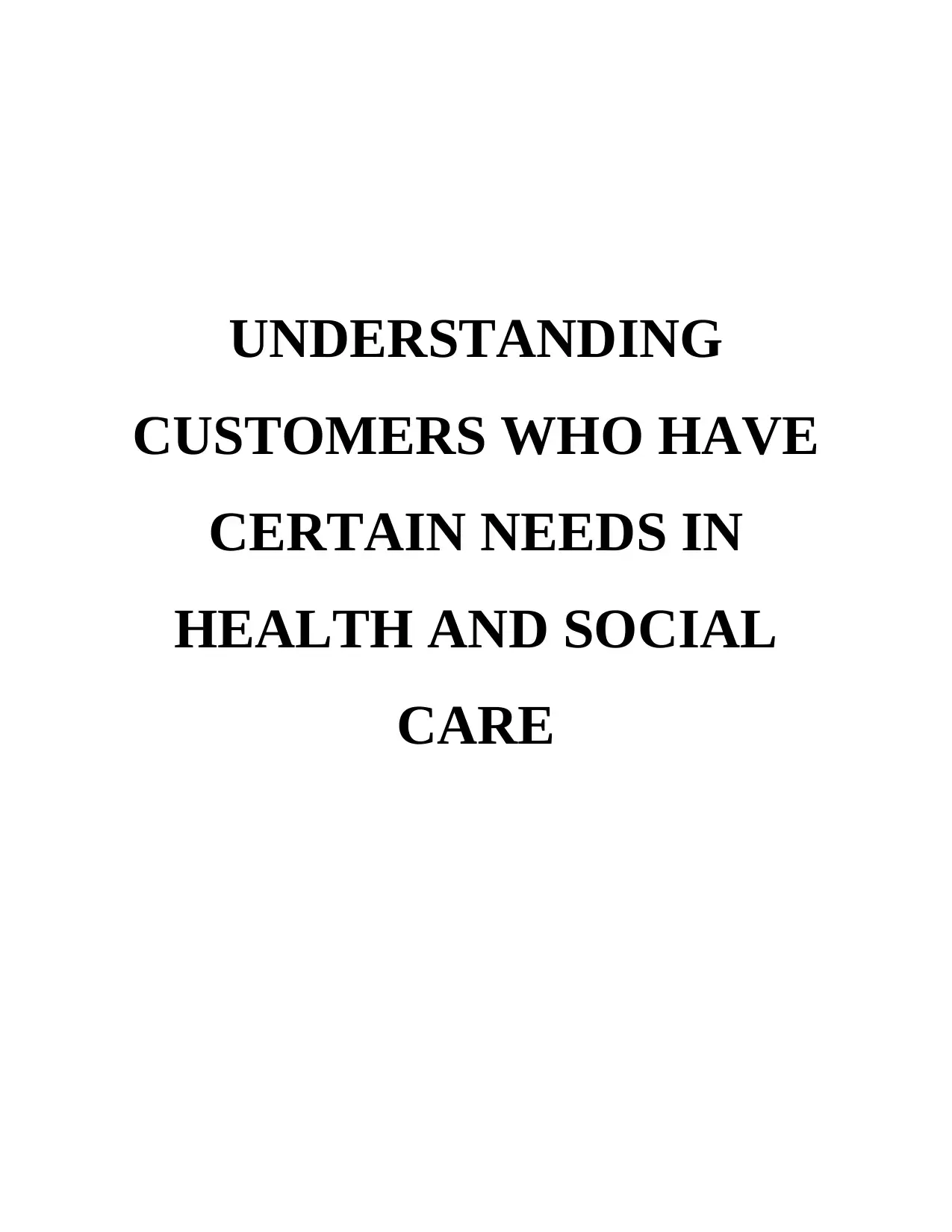
UNDERSTANDING
CUSTOMERS WHO HAVE
CERTAIN NEEDS IN
HEALTH AND SOCIAL
CARE
CUSTOMERS WHO HAVE
CERTAIN NEEDS IN
HEALTH AND SOCIAL
CARE
Paraphrase This Document
Need a fresh take? Get an instant paraphrase of this document with our AI Paraphraser

Table of Contents
INTRODUCTION...........................................................................................................................1
TASK 1............................................................................................................................................1
1.1 Concept of disability, illness, health and behaviour.............................................................1
1.2 Perceptions about specific needs...........................................................................................2
1.3 Impact of legislation, social policies, society and culture on the way of availing services. 2
TASK 2............................................................................................................................................3
2.1 Different care needs of persons like Anis, his wife and his daughter...................................3
2.2 Current system supporting this family..................................................................................3
2.3 Services available in a chosen locality for the individuals with specific needs....................3
TASK 3............................................................................................................................................3
3.1 Approaches and intervention strategies that supports individuals with specific needs.........3
3.2 Effectiveness of intervention strategies used for service users with specific needs.............4
3.3 Impact of emerging developments on support for persons with specific needs...................5
TASK 4............................................................................................................................................6
4.1 Different concepts of challenging behaviour........................................................................6
4.2 Potential impact of challenging behaviour on health and social care organisation..............7
4.3 Strategies for working with challenging behaviours associated with specific needs............8
CONCLUSION................................................................................................................................9
REFERENCES..............................................................................................................................10
INTRODUCTION...........................................................................................................................1
TASK 1............................................................................................................................................1
1.1 Concept of disability, illness, health and behaviour.............................................................1
1.2 Perceptions about specific needs...........................................................................................2
1.3 Impact of legislation, social policies, society and culture on the way of availing services. 2
TASK 2............................................................................................................................................3
2.1 Different care needs of persons like Anis, his wife and his daughter...................................3
2.2 Current system supporting this family..................................................................................3
2.3 Services available in a chosen locality for the individuals with specific needs....................3
TASK 3............................................................................................................................................3
3.1 Approaches and intervention strategies that supports individuals with specific needs.........3
3.2 Effectiveness of intervention strategies used for service users with specific needs.............4
3.3 Impact of emerging developments on support for persons with specific needs...................5
TASK 4............................................................................................................................................6
4.1 Different concepts of challenging behaviour........................................................................6
4.2 Potential impact of challenging behaviour on health and social care organisation..............7
4.3 Strategies for working with challenging behaviours associated with specific needs............8
CONCLUSION................................................................................................................................9
REFERENCES..............................................................................................................................10
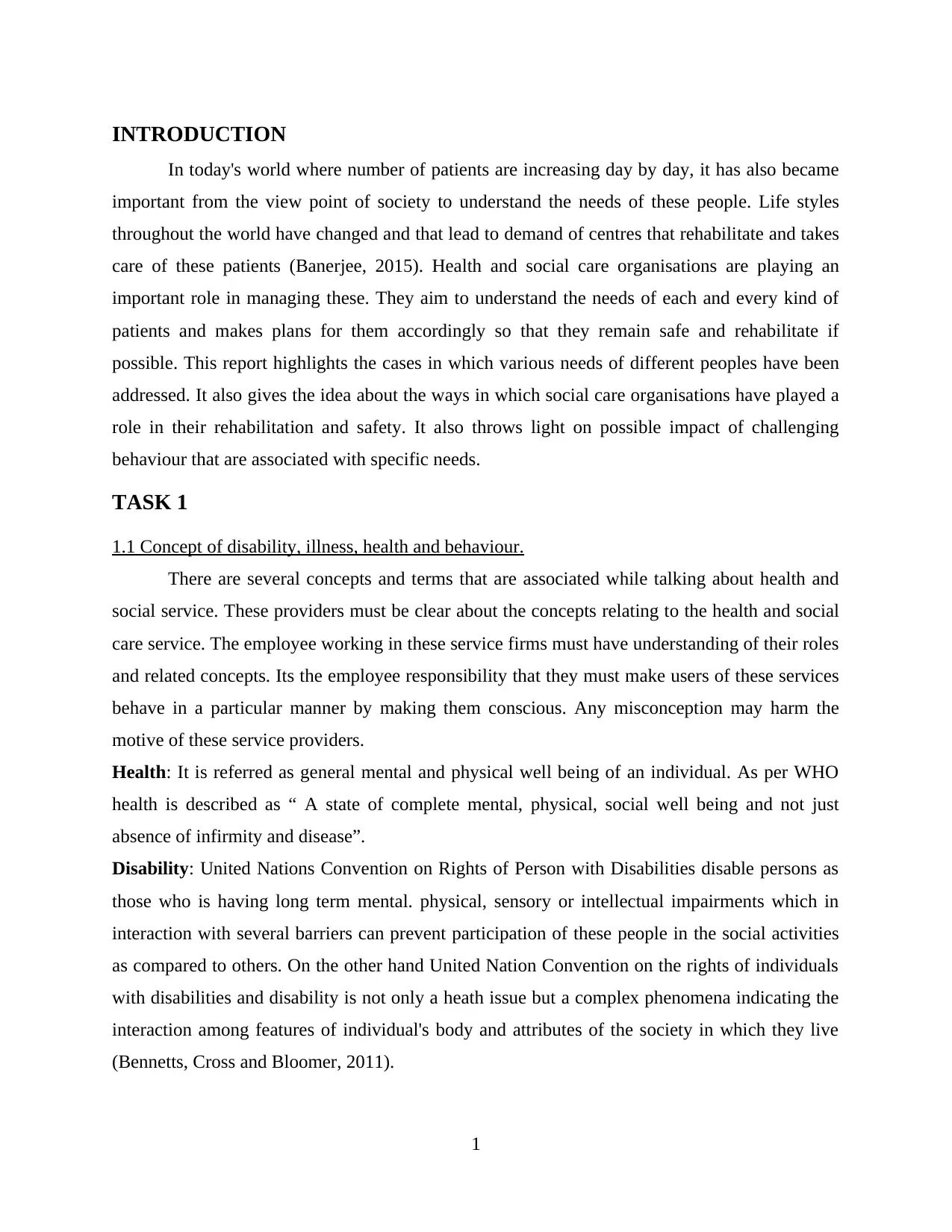
INTRODUCTION
In today's world where number of patients are increasing day by day, it has also became
important from the view point of society to understand the needs of these people. Life styles
throughout the world have changed and that lead to demand of centres that rehabilitate and takes
care of these patients (Banerjee, 2015). Health and social care organisations are playing an
important role in managing these. They aim to understand the needs of each and every kind of
patients and makes plans for them accordingly so that they remain safe and rehabilitate if
possible. This report highlights the cases in which various needs of different peoples have been
addressed. It also gives the idea about the ways in which social care organisations have played a
role in their rehabilitation and safety. It also throws light on possible impact of challenging
behaviour that are associated with specific needs.
TASK 1
1.1 Concept of disability, illness, health and behaviour.
There are several concepts and terms that are associated while talking about health and
social service. These providers must be clear about the concepts relating to the health and social
care service. The employee working in these service firms must have understanding of their roles
and related concepts. Its the employee responsibility that they must make users of these services
behave in a particular manner by making them conscious. Any misconception may harm the
motive of these service providers.
Health: It is referred as general mental and physical well being of an individual. As per WHO
health is described as “ A state of complete mental, physical, social well being and not just
absence of infirmity and disease”.
Disability: United Nations Convention on Rights of Person with Disabilities disable persons as
those who is having long term mental. physical, sensory or intellectual impairments which in
interaction with several barriers can prevent participation of these people in the social activities
as compared to others. On the other hand United Nation Convention on the rights of individuals
with disabilities and disability is not only a heath issue but a complex phenomena indicating the
interaction among features of individual's body and attributes of the society in which they live
(Bennetts, Cross and Bloomer, 2011).
1
In today's world where number of patients are increasing day by day, it has also became
important from the view point of society to understand the needs of these people. Life styles
throughout the world have changed and that lead to demand of centres that rehabilitate and takes
care of these patients (Banerjee, 2015). Health and social care organisations are playing an
important role in managing these. They aim to understand the needs of each and every kind of
patients and makes plans for them accordingly so that they remain safe and rehabilitate if
possible. This report highlights the cases in which various needs of different peoples have been
addressed. It also gives the idea about the ways in which social care organisations have played a
role in their rehabilitation and safety. It also throws light on possible impact of challenging
behaviour that are associated with specific needs.
TASK 1
1.1 Concept of disability, illness, health and behaviour.
There are several concepts and terms that are associated while talking about health and
social service. These providers must be clear about the concepts relating to the health and social
care service. The employee working in these service firms must have understanding of their roles
and related concepts. Its the employee responsibility that they must make users of these services
behave in a particular manner by making them conscious. Any misconception may harm the
motive of these service providers.
Health: It is referred as general mental and physical well being of an individual. As per WHO
health is described as “ A state of complete mental, physical, social well being and not just
absence of infirmity and disease”.
Disability: United Nations Convention on Rights of Person with Disabilities disable persons as
those who is having long term mental. physical, sensory or intellectual impairments which in
interaction with several barriers can prevent participation of these people in the social activities
as compared to others. On the other hand United Nation Convention on the rights of individuals
with disabilities and disability is not only a heath issue but a complex phenomena indicating the
interaction among features of individual's body and attributes of the society in which they live
(Bennetts, Cross and Bloomer, 2011).
1
⊘ This is a preview!⊘
Do you want full access?
Subscribe today to unlock all pages.

Trusted by 1+ million students worldwide

Illness: It is a subjective issue that may differ from individual to individual on the basis of
personal emotion and perception. How so ever the illness concept plays a vital role in diagnosing
sickness and disease. Behaviour of illness is defined as the manner in which individual monitor
their bodies, defines and interprets their symptoms and are taking remedial action, and use of
health care system and several other sources that assist in this matter (Chakraborty and
Majumdar, 2011).
1.2 Perceptions about specific needs.
There are several needs of the society that has changed over the years and so is the
perception about these needs have also changed. Individuals with specific needs have
transformed significantly over the years. These people are more vulnerable to harm, abuse,
deprivation, exploitation and violation that other sections of the society. Their vulnerability
consequences if not addressed or recognised properly can sometimes become life threatening for
their mental or physical well being which may have impact on their ability to access their basic
human rights. It is possible the person with these needs may not have access to the effective
communication channel from where they can know their potential needs. In order to understand
why perceptions have changed over the years these reasons needs to be considered:
Changing values, trends and customs of society have also changed the perception about
these needs.
People do not have time for taking care of these persons with specific needs and hence
are unable to understand.
People's physiological changes have made this issue more adverse.
This can also be seen with the case study that Peter in the age 42 years that he needs 24 hour
support but is unable to get that in present society. It has impacted on the rights which he has got.
Perception about these diseases as well as government policies have made him to consult Health
and Social care service provider regarding his disability and illness (Drotz and Poksinska, 2014).
1.3 Impact of legislation, social policies, society and culture on the way of availing services.
Society, its legislation and policies, values, culture are changing and so is their impact on
the ways in which these services can be provided to the people like peter who have specific
needs. These impacts have been illustrated through these points:
Legislation impact: Legislations around the world have ensured that the rights of these
peoples with specific needs must be safeguarded. They ensures the existence of health
2
personal emotion and perception. How so ever the illness concept plays a vital role in diagnosing
sickness and disease. Behaviour of illness is defined as the manner in which individual monitor
their bodies, defines and interprets their symptoms and are taking remedial action, and use of
health care system and several other sources that assist in this matter (Chakraborty and
Majumdar, 2011).
1.2 Perceptions about specific needs.
There are several needs of the society that has changed over the years and so is the
perception about these needs have also changed. Individuals with specific needs have
transformed significantly over the years. These people are more vulnerable to harm, abuse,
deprivation, exploitation and violation that other sections of the society. Their vulnerability
consequences if not addressed or recognised properly can sometimes become life threatening for
their mental or physical well being which may have impact on their ability to access their basic
human rights. It is possible the person with these needs may not have access to the effective
communication channel from where they can know their potential needs. In order to understand
why perceptions have changed over the years these reasons needs to be considered:
Changing values, trends and customs of society have also changed the perception about
these needs.
People do not have time for taking care of these persons with specific needs and hence
are unable to understand.
People's physiological changes have made this issue more adverse.
This can also be seen with the case study that Peter in the age 42 years that he needs 24 hour
support but is unable to get that in present society. It has impacted on the rights which he has got.
Perception about these diseases as well as government policies have made him to consult Health
and Social care service provider regarding his disability and illness (Drotz and Poksinska, 2014).
1.3 Impact of legislation, social policies, society and culture on the way of availing services.
Society, its legislation and policies, values, culture are changing and so is their impact on
the ways in which these services can be provided to the people like peter who have specific
needs. These impacts have been illustrated through these points:
Legislation impact: Legislations around the world have ensured that the rights of these
peoples with specific needs must be safeguarded. They ensures the existence of health
2
Paraphrase This Document
Need a fresh take? Get an instant paraphrase of this document with our AI Paraphraser
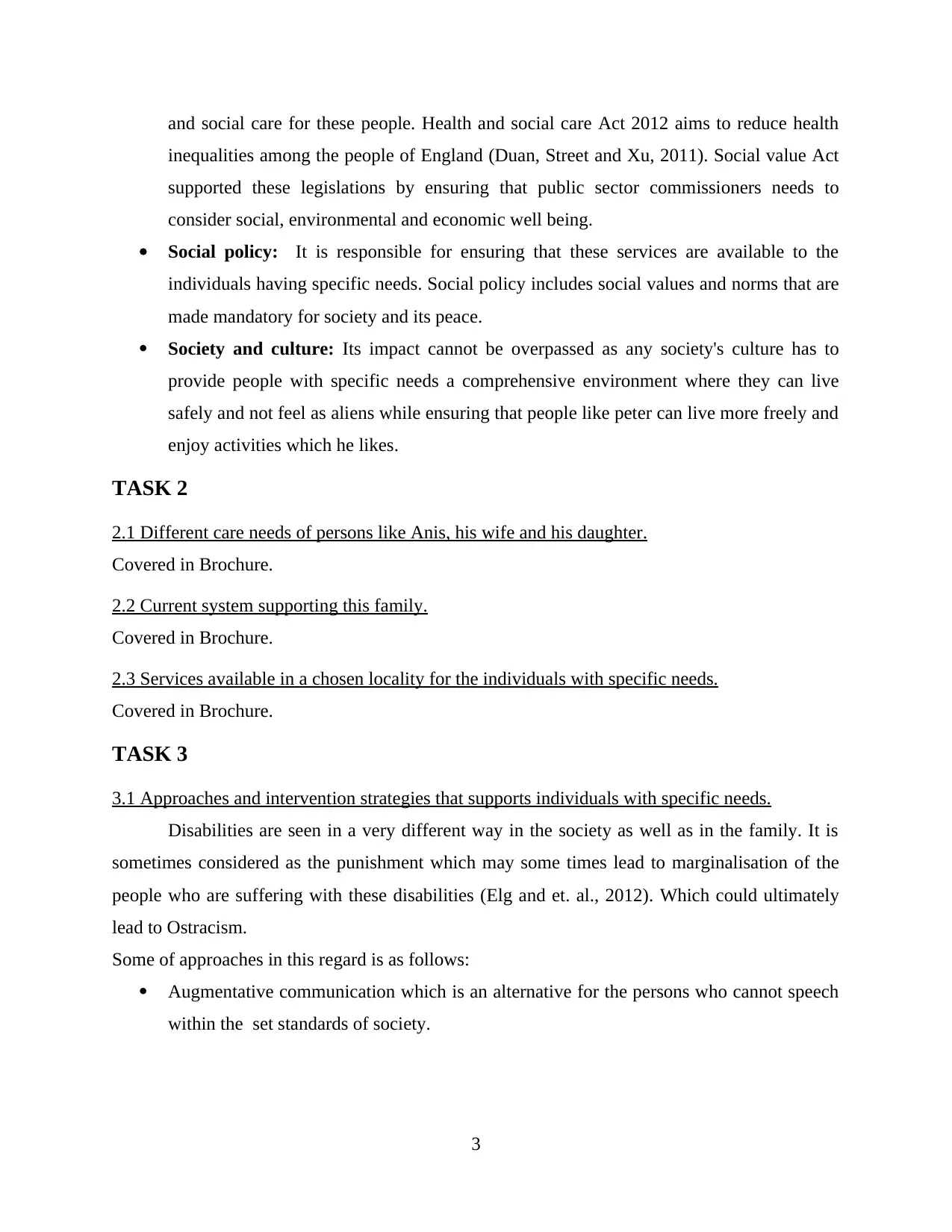
and social care for these people. Health and social care Act 2012 aims to reduce health
inequalities among the people of England (Duan, Street and Xu, 2011). Social value Act
supported these legislations by ensuring that public sector commissioners needs to
consider social, environmental and economic well being.
Social policy: It is responsible for ensuring that these services are available to the
individuals having specific needs. Social policy includes social values and norms that are
made mandatory for society and its peace.
Society and culture: Its impact cannot be overpassed as any society's culture has to
provide people with specific needs a comprehensive environment where they can live
safely and not feel as aliens while ensuring that people like peter can live more freely and
enjoy activities which he likes.
TASK 2
2.1 Different care needs of persons like Anis, his wife and his daughter.
Covered in Brochure.
2.2 Current system supporting this family.
Covered in Brochure.
2.3 Services available in a chosen locality for the individuals with specific needs.
Covered in Brochure.
TASK 3
3.1 Approaches and intervention strategies that supports individuals with specific needs.
Disabilities are seen in a very different way in the society as well as in the family. It is
sometimes considered as the punishment which may some times lead to marginalisation of the
people who are suffering with these disabilities (Elg and et. al., 2012). Which could ultimately
lead to Ostracism.
Some of approaches in this regard is as follows:
Augmentative communication which is an alternative for the persons who cannot speech
within the set standards of society.
3
inequalities among the people of England (Duan, Street and Xu, 2011). Social value Act
supported these legislations by ensuring that public sector commissioners needs to
consider social, environmental and economic well being.
Social policy: It is responsible for ensuring that these services are available to the
individuals having specific needs. Social policy includes social values and norms that are
made mandatory for society and its peace.
Society and culture: Its impact cannot be overpassed as any society's culture has to
provide people with specific needs a comprehensive environment where they can live
safely and not feel as aliens while ensuring that people like peter can live more freely and
enjoy activities which he likes.
TASK 2
2.1 Different care needs of persons like Anis, his wife and his daughter.
Covered in Brochure.
2.2 Current system supporting this family.
Covered in Brochure.
2.3 Services available in a chosen locality for the individuals with specific needs.
Covered in Brochure.
TASK 3
3.1 Approaches and intervention strategies that supports individuals with specific needs.
Disabilities are seen in a very different way in the society as well as in the family. It is
sometimes considered as the punishment which may some times lead to marginalisation of the
people who are suffering with these disabilities (Elg and et. al., 2012). Which could ultimately
lead to Ostracism.
Some of approaches in this regard is as follows:
Augmentative communication which is an alternative for the persons who cannot speech
within the set standards of society.
3
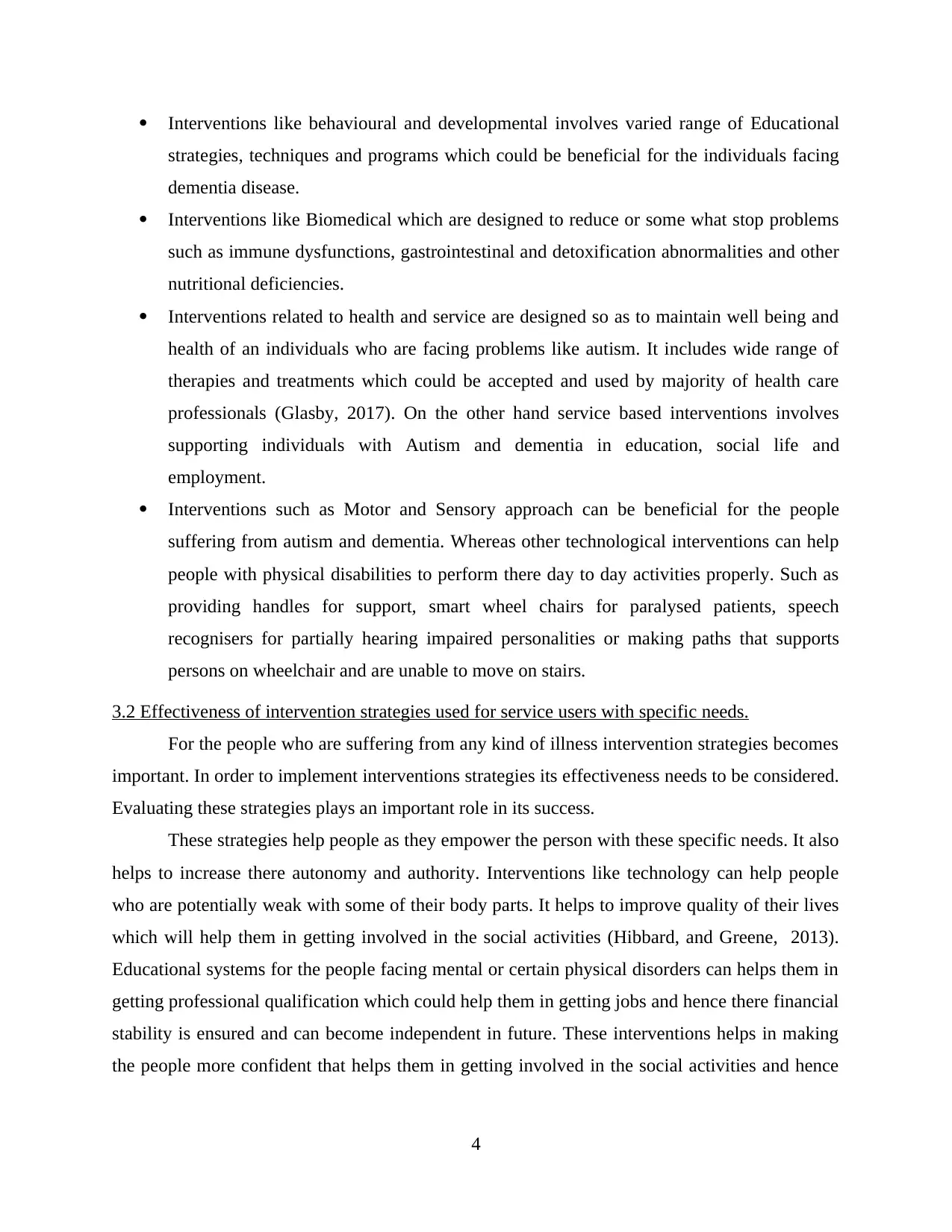
Interventions like behavioural and developmental involves varied range of Educational
strategies, techniques and programs which could be beneficial for the individuals facing
dementia disease.
Interventions like Biomedical which are designed to reduce or some what stop problems
such as immune dysfunctions, gastrointestinal and detoxification abnormalities and other
nutritional deficiencies.
Interventions related to health and service are designed so as to maintain well being and
health of an individuals who are facing problems like autism. It includes wide range of
therapies and treatments which could be accepted and used by majority of health care
professionals (Glasby, 2017). On the other hand service based interventions involves
supporting individuals with Autism and dementia in education, social life and
employment.
Interventions such as Motor and Sensory approach can be beneficial for the people
suffering from autism and dementia. Whereas other technological interventions can help
people with physical disabilities to perform there day to day activities properly. Such as
providing handles for support, smart wheel chairs for paralysed patients, speech
recognisers for partially hearing impaired personalities or making paths that supports
persons on wheelchair and are unable to move on stairs.
3.2 Effectiveness of intervention strategies used for service users with specific needs.
For the people who are suffering from any kind of illness intervention strategies becomes
important. In order to implement interventions strategies its effectiveness needs to be considered.
Evaluating these strategies plays an important role in its success.
These strategies help people as they empower the person with these specific needs. It also
helps to increase there autonomy and authority. Interventions like technology can help people
who are potentially weak with some of their body parts. It helps to improve quality of their lives
which will help them in getting involved in the social activities (Hibbard, and Greene, 2013).
Educational systems for the people facing mental or certain physical disorders can helps them in
getting professional qualification which could help them in getting jobs and hence there financial
stability is ensured and can become independent in future. These interventions helps in making
the people more confident that helps them in getting involved in the social activities and hence
4
strategies, techniques and programs which could be beneficial for the individuals facing
dementia disease.
Interventions like Biomedical which are designed to reduce or some what stop problems
such as immune dysfunctions, gastrointestinal and detoxification abnormalities and other
nutritional deficiencies.
Interventions related to health and service are designed so as to maintain well being and
health of an individuals who are facing problems like autism. It includes wide range of
therapies and treatments which could be accepted and used by majority of health care
professionals (Glasby, 2017). On the other hand service based interventions involves
supporting individuals with Autism and dementia in education, social life and
employment.
Interventions such as Motor and Sensory approach can be beneficial for the people
suffering from autism and dementia. Whereas other technological interventions can help
people with physical disabilities to perform there day to day activities properly. Such as
providing handles for support, smart wheel chairs for paralysed patients, speech
recognisers for partially hearing impaired personalities or making paths that supports
persons on wheelchair and are unable to move on stairs.
3.2 Effectiveness of intervention strategies used for service users with specific needs.
For the people who are suffering from any kind of illness intervention strategies becomes
important. In order to implement interventions strategies its effectiveness needs to be considered.
Evaluating these strategies plays an important role in its success.
These strategies help people as they empower the person with these specific needs. It also
helps to increase there autonomy and authority. Interventions like technology can help people
who are potentially weak with some of their body parts. It helps to improve quality of their lives
which will help them in getting involved in the social activities (Hibbard, and Greene, 2013).
Educational systems for the people facing mental or certain physical disorders can helps them in
getting professional qualification which could help them in getting jobs and hence there financial
stability is ensured and can become independent in future. These interventions helps in making
the people more confident that helps them in getting involved in the social activities and hence
4
⊘ This is a preview!⊘
Do you want full access?
Subscribe today to unlock all pages.

Trusted by 1+ million students worldwide
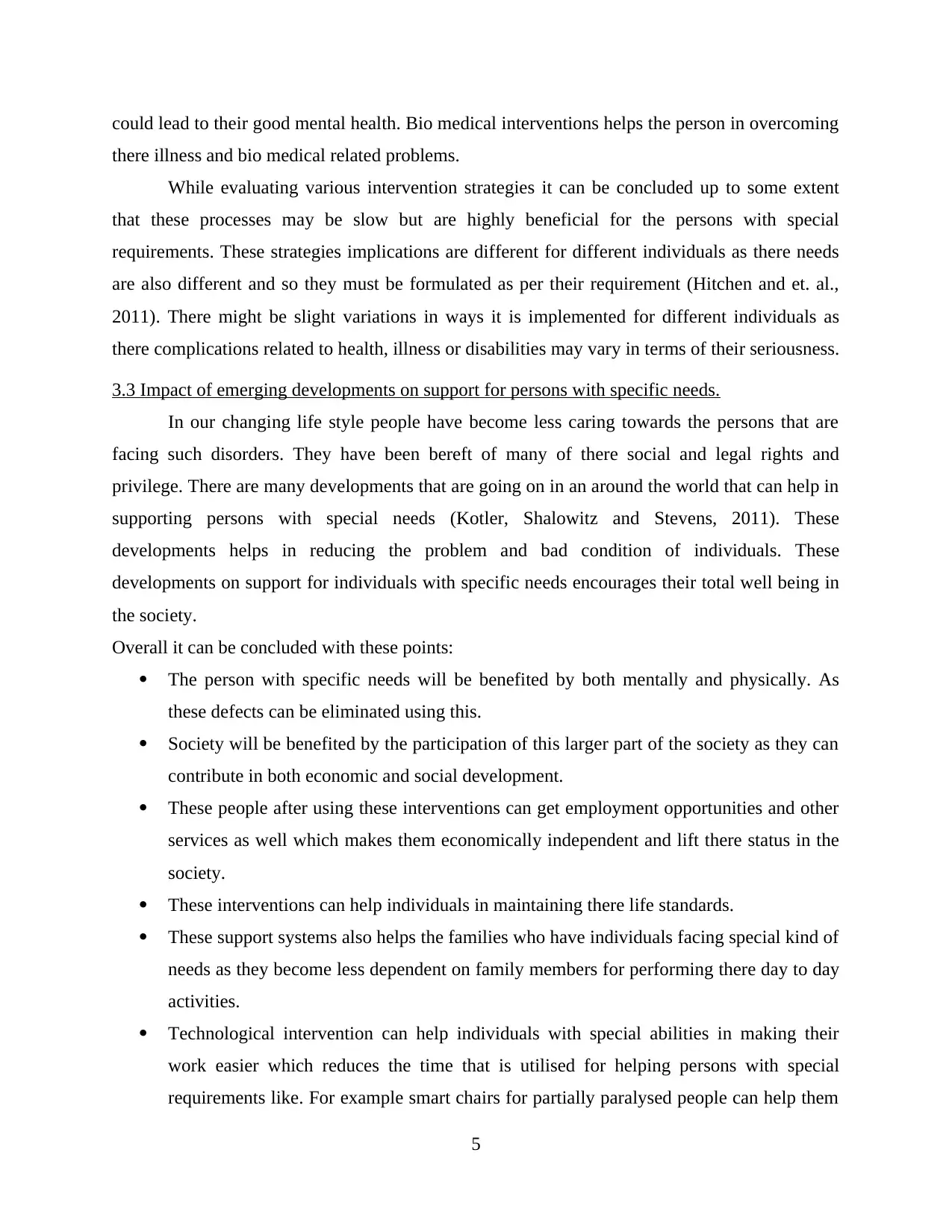
could lead to their good mental health. Bio medical interventions helps the person in overcoming
there illness and bio medical related problems.
While evaluating various intervention strategies it can be concluded up to some extent
that these processes may be slow but are highly beneficial for the persons with special
requirements. These strategies implications are different for different individuals as there needs
are also different and so they must be formulated as per their requirement (Hitchen and et. al.,
2011). There might be slight variations in ways it is implemented for different individuals as
there complications related to health, illness or disabilities may vary in terms of their seriousness.
3.3 Impact of emerging developments on support for persons with specific needs.
In our changing life style people have become less caring towards the persons that are
facing such disorders. They have been bereft of many of there social and legal rights and
privilege. There are many developments that are going on in an around the world that can help in
supporting persons with special needs (Kotler, Shalowitz and Stevens, 2011). These
developments helps in reducing the problem and bad condition of individuals. These
developments on support for individuals with specific needs encourages their total well being in
the society.
Overall it can be concluded with these points:
The person with specific needs will be benefited by both mentally and physically. As
these defects can be eliminated using this.
Society will be benefited by the participation of this larger part of the society as they can
contribute in both economic and social development.
These people after using these interventions can get employment opportunities and other
services as well which makes them economically independent and lift there status in the
society.
These interventions can help individuals in maintaining there life standards.
These support systems also helps the families who have individuals facing special kind of
needs as they become less dependent on family members for performing there day to day
activities.
Technological intervention can help individuals with special abilities in making their
work easier which reduces the time that is utilised for helping persons with special
requirements like. For example smart chairs for partially paralysed people can help them
5
there illness and bio medical related problems.
While evaluating various intervention strategies it can be concluded up to some extent
that these processes may be slow but are highly beneficial for the persons with special
requirements. These strategies implications are different for different individuals as there needs
are also different and so they must be formulated as per their requirement (Hitchen and et. al.,
2011). There might be slight variations in ways it is implemented for different individuals as
there complications related to health, illness or disabilities may vary in terms of their seriousness.
3.3 Impact of emerging developments on support for persons with specific needs.
In our changing life style people have become less caring towards the persons that are
facing such disorders. They have been bereft of many of there social and legal rights and
privilege. There are many developments that are going on in an around the world that can help in
supporting persons with special needs (Kotler, Shalowitz and Stevens, 2011). These
developments helps in reducing the problem and bad condition of individuals. These
developments on support for individuals with specific needs encourages their total well being in
the society.
Overall it can be concluded with these points:
The person with specific needs will be benefited by both mentally and physically. As
these defects can be eliminated using this.
Society will be benefited by the participation of this larger part of the society as they can
contribute in both economic and social development.
These people after using these interventions can get employment opportunities and other
services as well which makes them economically independent and lift there status in the
society.
These interventions can help individuals in maintaining there life standards.
These support systems also helps the families who have individuals facing special kind of
needs as they become less dependent on family members for performing there day to day
activities.
Technological intervention can help individuals with special abilities in making their
work easier which reduces the time that is utilised for helping persons with special
requirements like. For example smart chairs for partially paralysed people can help them
5
Paraphrase This Document
Need a fresh take? Get an instant paraphrase of this document with our AI Paraphraser

in moving from one place to another which was previously done with the help of another
person of the family.
Emerging developments in bio medical sciences help individuals with special needs in
their rehabilitation process. For example some special therapies helps to cure paralysis up
to certain extent.
TASK 4
4.1 Different concepts of challenging behaviour.
Challenging behaviour is also understood as the behaviour that challenges the services of
the Health and social care. It is also defined as the culturally abnormal behaviour of such
intensities, duration or frequency that differs from the normal persons in the society. These
abnormal behaviours can harm individuals themselves or the persons around them (Krumholz,
2014). This leads them from going to social places as there behaviour can be threat to
community and its facilities.
This case study illustrates the abnormal or challenging behaviour of Mr. JC who is 85 years old.
Some of his challenging behaviour includes:
Being excessively angry if any thing goes wrong or any thing doesn't works as per his
expectations.
Sharing extremely disheartening and degrading words with the staff members of Day
Care that too in his native tongue.
Abusing employees or people who is responsible for the fault as he only believes that
manager is good and other staffs members have bad manners.
There are basically three kinds of theories that are prevalent and used to describe challenging
behaviour of persons
Pre-scientific theory:
It is a superstitious theory.
It is believed the these behaviours are developed due to superstitious powers and cannot
be eliminated with medicine.
They believe that demons posses them and hence they are acting in such a way and hence
made them behaviourally different (McColl-Kennedy and et. al., 2012).
Due to this believe these people are not provided with proper medications
6
person of the family.
Emerging developments in bio medical sciences help individuals with special needs in
their rehabilitation process. For example some special therapies helps to cure paralysis up
to certain extent.
TASK 4
4.1 Different concepts of challenging behaviour.
Challenging behaviour is also understood as the behaviour that challenges the services of
the Health and social care. It is also defined as the culturally abnormal behaviour of such
intensities, duration or frequency that differs from the normal persons in the society. These
abnormal behaviours can harm individuals themselves or the persons around them (Krumholz,
2014). This leads them from going to social places as there behaviour can be threat to
community and its facilities.
This case study illustrates the abnormal or challenging behaviour of Mr. JC who is 85 years old.
Some of his challenging behaviour includes:
Being excessively angry if any thing goes wrong or any thing doesn't works as per his
expectations.
Sharing extremely disheartening and degrading words with the staff members of Day
Care that too in his native tongue.
Abusing employees or people who is responsible for the fault as he only believes that
manager is good and other staffs members have bad manners.
There are basically three kinds of theories that are prevalent and used to describe challenging
behaviour of persons
Pre-scientific theory:
It is a superstitious theory.
It is believed the these behaviours are developed due to superstitious powers and cannot
be eliminated with medicine.
They believe that demons posses them and hence they are acting in such a way and hence
made them behaviourally different (McColl-Kennedy and et. al., 2012).
Due to this believe these people are not provided with proper medications
6
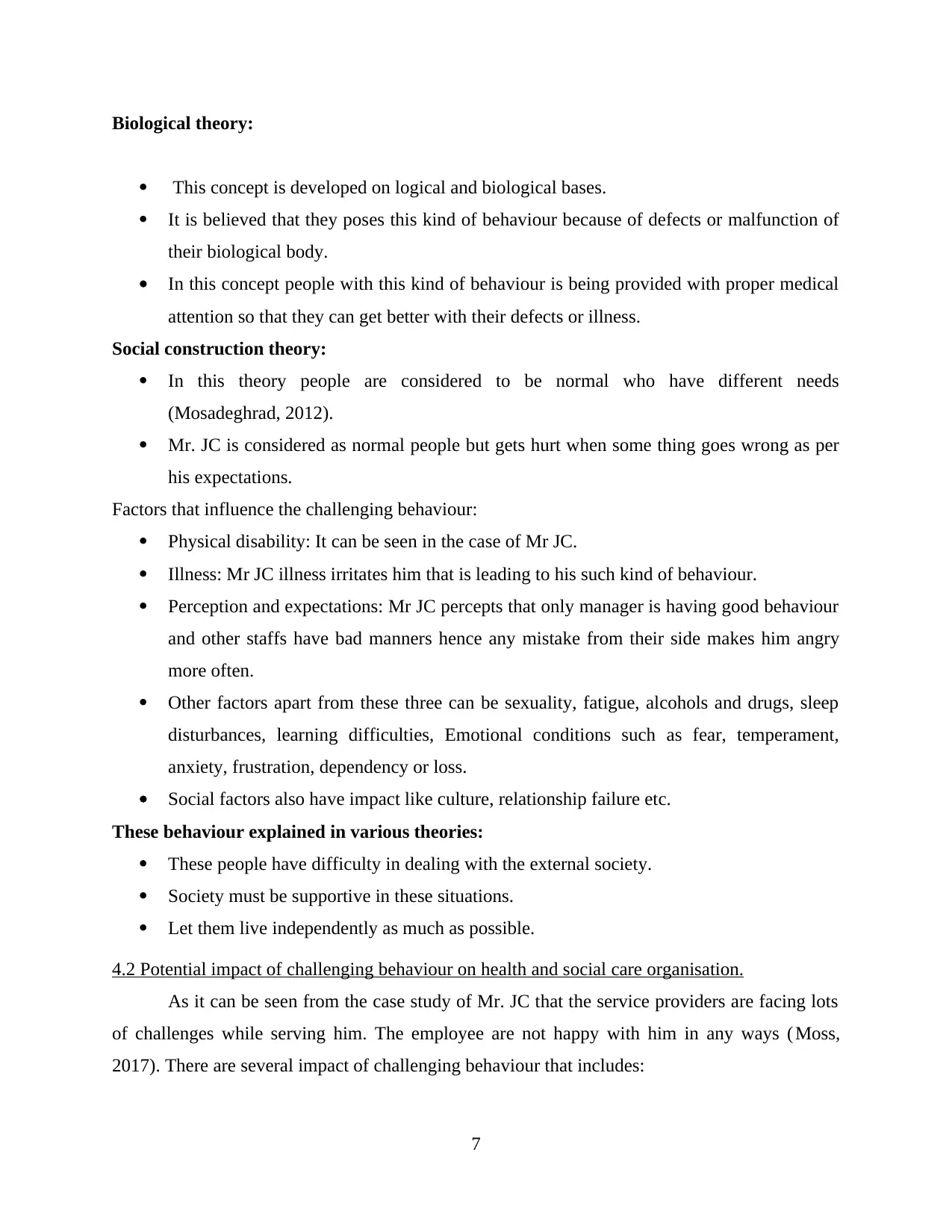
Biological theory:
This concept is developed on logical and biological bases.
It is believed that they poses this kind of behaviour because of defects or malfunction of
their biological body.
In this concept people with this kind of behaviour is being provided with proper medical
attention so that they can get better with their defects or illness.
Social construction theory:
In this theory people are considered to be normal who have different needs
(Mosadeghrad, 2012).
Mr. JC is considered as normal people but gets hurt when some thing goes wrong as per
his expectations.
Factors that influence the challenging behaviour:
Physical disability: It can be seen in the case of Mr JC.
Illness: Mr JC illness irritates him that is leading to his such kind of behaviour.
Perception and expectations: Mr JC percepts that only manager is having good behaviour
and other staffs have bad manners hence any mistake from their side makes him angry
more often.
Other factors apart from these three can be sexuality, fatigue, alcohols and drugs, sleep
disturbances, learning difficulties, Emotional conditions such as fear, temperament,
anxiety, frustration, dependency or loss.
Social factors also have impact like culture, relationship failure etc.
These behaviour explained in various theories:
These people have difficulty in dealing with the external society.
Society must be supportive in these situations.
Let them live independently as much as possible.
4.2 Potential impact of challenging behaviour on health and social care organisation.
As it can be seen from the case study of Mr. JC that the service providers are facing lots
of challenges while serving him. The employee are not happy with him in any ways (Moss,
2017). There are several impact of challenging behaviour that includes:
7
This concept is developed on logical and biological bases.
It is believed that they poses this kind of behaviour because of defects or malfunction of
their biological body.
In this concept people with this kind of behaviour is being provided with proper medical
attention so that they can get better with their defects or illness.
Social construction theory:
In this theory people are considered to be normal who have different needs
(Mosadeghrad, 2012).
Mr. JC is considered as normal people but gets hurt when some thing goes wrong as per
his expectations.
Factors that influence the challenging behaviour:
Physical disability: It can be seen in the case of Mr JC.
Illness: Mr JC illness irritates him that is leading to his such kind of behaviour.
Perception and expectations: Mr JC percepts that only manager is having good behaviour
and other staffs have bad manners hence any mistake from their side makes him angry
more often.
Other factors apart from these three can be sexuality, fatigue, alcohols and drugs, sleep
disturbances, learning difficulties, Emotional conditions such as fear, temperament,
anxiety, frustration, dependency or loss.
Social factors also have impact like culture, relationship failure etc.
These behaviour explained in various theories:
These people have difficulty in dealing with the external society.
Society must be supportive in these situations.
Let them live independently as much as possible.
4.2 Potential impact of challenging behaviour on health and social care organisation.
As it can be seen from the case study of Mr. JC that the service providers are facing lots
of challenges while serving him. The employee are not happy with him in any ways (Moss,
2017). There are several impact of challenging behaviour that includes:
7
⊘ This is a preview!⊘
Do you want full access?
Subscribe today to unlock all pages.

Trusted by 1+ million students worldwide
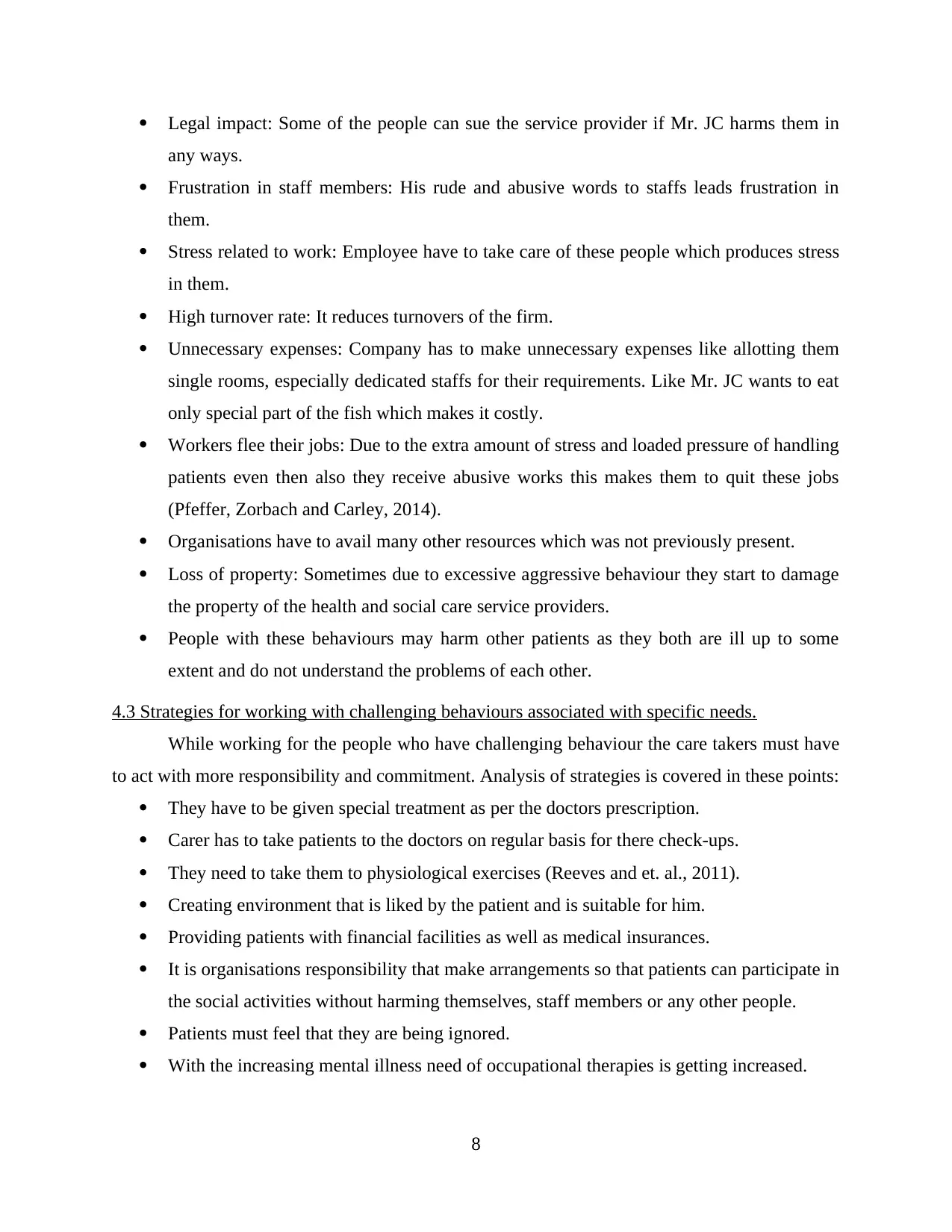
Legal impact: Some of the people can sue the service provider if Mr. JC harms them in
any ways.
Frustration in staff members: His rude and abusive words to staffs leads frustration in
them.
Stress related to work: Employee have to take care of these people which produces stress
in them.
High turnover rate: It reduces turnovers of the firm.
Unnecessary expenses: Company has to make unnecessary expenses like allotting them
single rooms, especially dedicated staffs for their requirements. Like Mr. JC wants to eat
only special part of the fish which makes it costly.
Workers flee their jobs: Due to the extra amount of stress and loaded pressure of handling
patients even then also they receive abusive works this makes them to quit these jobs
(Pfeffer, Zorbach and Carley, 2014).
Organisations have to avail many other resources which was not previously present.
Loss of property: Sometimes due to excessive aggressive behaviour they start to damage
the property of the health and social care service providers.
People with these behaviours may harm other patients as they both are ill up to some
extent and do not understand the problems of each other.
4.3 Strategies for working with challenging behaviours associated with specific needs.
While working for the people who have challenging behaviour the care takers must have
to act with more responsibility and commitment. Analysis of strategies is covered in these points:
They have to be given special treatment as per the doctors prescription.
Carer has to take patients to the doctors on regular basis for there check-ups.
They need to take them to physiological exercises (Reeves and et. al., 2011).
Creating environment that is liked by the patient and is suitable for him.
Providing patients with financial facilities as well as medical insurances.
It is organisations responsibility that make arrangements so that patients can participate in
the social activities without harming themselves, staff members or any other people.
Patients must feel that they are being ignored.
With the increasing mental illness need of occupational therapies is getting increased.
8
any ways.
Frustration in staff members: His rude and abusive words to staffs leads frustration in
them.
Stress related to work: Employee have to take care of these people which produces stress
in them.
High turnover rate: It reduces turnovers of the firm.
Unnecessary expenses: Company has to make unnecessary expenses like allotting them
single rooms, especially dedicated staffs for their requirements. Like Mr. JC wants to eat
only special part of the fish which makes it costly.
Workers flee their jobs: Due to the extra amount of stress and loaded pressure of handling
patients even then also they receive abusive works this makes them to quit these jobs
(Pfeffer, Zorbach and Carley, 2014).
Organisations have to avail many other resources which was not previously present.
Loss of property: Sometimes due to excessive aggressive behaviour they start to damage
the property of the health and social care service providers.
People with these behaviours may harm other patients as they both are ill up to some
extent and do not understand the problems of each other.
4.3 Strategies for working with challenging behaviours associated with specific needs.
While working for the people who have challenging behaviour the care takers must have
to act with more responsibility and commitment. Analysis of strategies is covered in these points:
They have to be given special treatment as per the doctors prescription.
Carer has to take patients to the doctors on regular basis for there check-ups.
They need to take them to physiological exercises (Reeves and et. al., 2011).
Creating environment that is liked by the patient and is suitable for him.
Providing patients with financial facilities as well as medical insurances.
It is organisations responsibility that make arrangements so that patients can participate in
the social activities without harming themselves, staff members or any other people.
Patients must feel that they are being ignored.
With the increasing mental illness need of occupational therapies is getting increased.
8
Paraphrase This Document
Need a fresh take? Get an instant paraphrase of this document with our AI Paraphraser
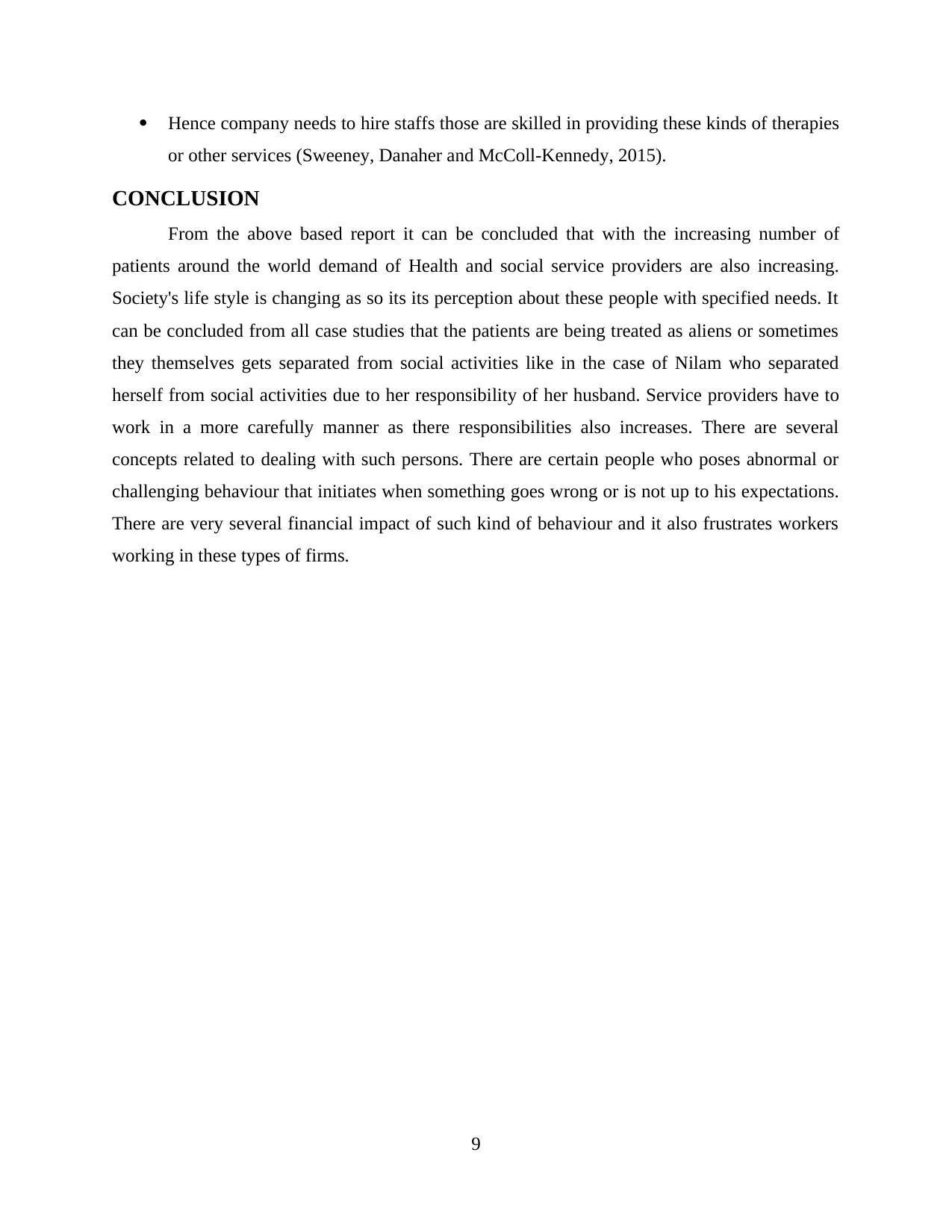
Hence company needs to hire staffs those are skilled in providing these kinds of therapies
or other services (Sweeney, Danaher and McColl-Kennedy, 2015).
CONCLUSION
From the above based report it can be concluded that with the increasing number of
patients around the world demand of Health and social service providers are also increasing.
Society's life style is changing as so its its perception about these people with specified needs. It
can be concluded from all case studies that the patients are being treated as aliens or sometimes
they themselves gets separated from social activities like in the case of Nilam who separated
herself from social activities due to her responsibility of her husband. Service providers have to
work in a more carefully manner as there responsibilities also increases. There are several
concepts related to dealing with such persons. There are certain people who poses abnormal or
challenging behaviour that initiates when something goes wrong or is not up to his expectations.
There are very several financial impact of such kind of behaviour and it also frustrates workers
working in these types of firms.
9
or other services (Sweeney, Danaher and McColl-Kennedy, 2015).
CONCLUSION
From the above based report it can be concluded that with the increasing number of
patients around the world demand of Health and social service providers are also increasing.
Society's life style is changing as so its its perception about these people with specified needs. It
can be concluded from all case studies that the patients are being treated as aliens or sometimes
they themselves gets separated from social activities like in the case of Nilam who separated
herself from social activities due to her responsibility of her husband. Service providers have to
work in a more carefully manner as there responsibilities also increases. There are several
concepts related to dealing with such persons. There are certain people who poses abnormal or
challenging behaviour that initiates when something goes wrong or is not up to his expectations.
There are very several financial impact of such kind of behaviour and it also frustrates workers
working in these types of firms.
9
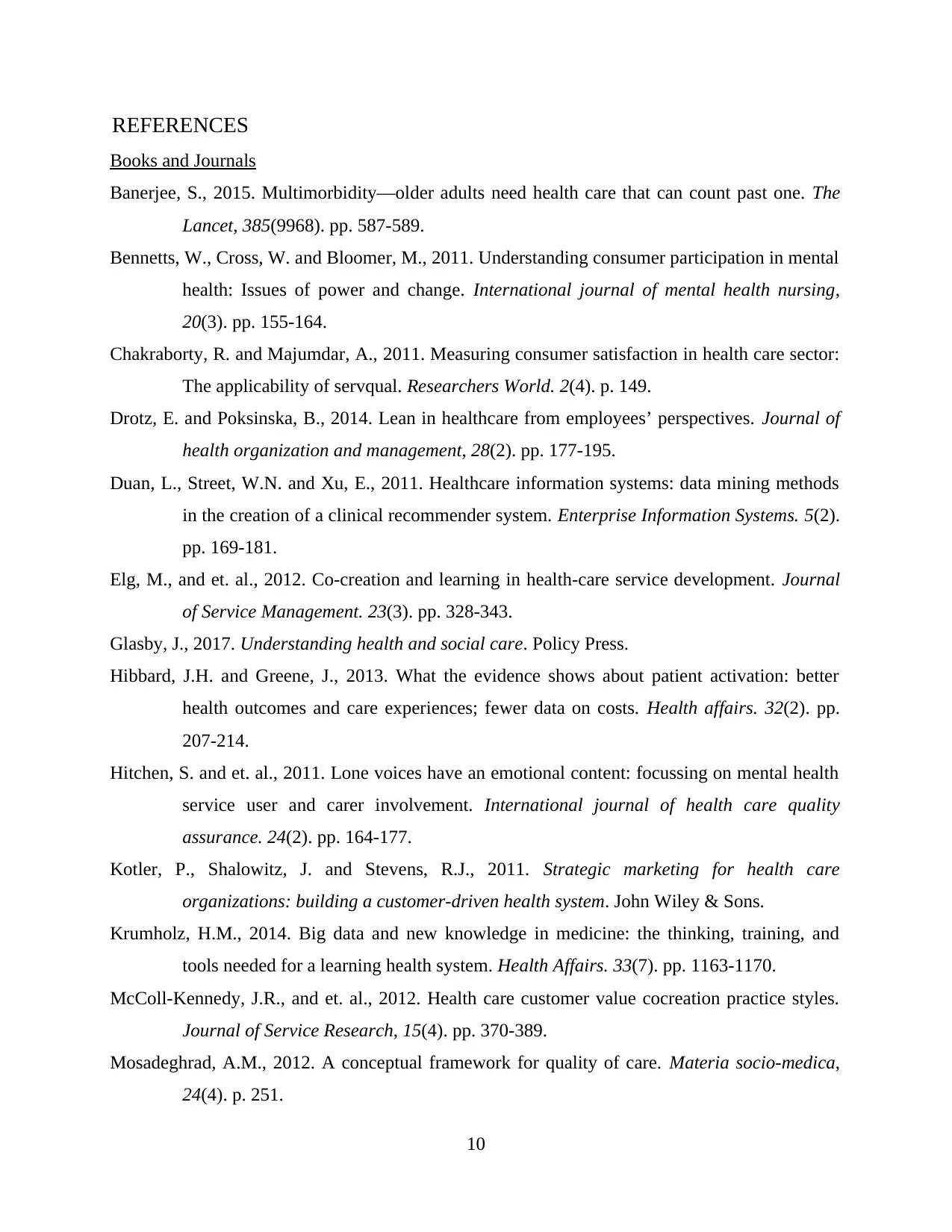
REFERENCES
Books and Journals
Banerjee, S., 2015. Multimorbidity—older adults need health care that can count past one. The
Lancet, 385(9968). pp. 587-589.
Bennetts, W., Cross, W. and Bloomer, M., 2011. Understanding consumer participation in mental
health: Issues of power and change. International journal of mental health nursing,
20(3). pp. 155-164.
Chakraborty, R. and Majumdar, A., 2011. Measuring consumer satisfaction in health care sector:
The applicability of servqual. Researchers World. 2(4). p. 149.
Drotz, E. and Poksinska, B., 2014. Lean in healthcare from employees’ perspectives. Journal of
health organization and management, 28(2). pp. 177-195.
Duan, L., Street, W.N. and Xu, E., 2011. Healthcare information systems: data mining methods
in the creation of a clinical recommender system. Enterprise Information Systems. 5(2).
pp. 169-181.
Elg, M., and et. al., 2012. Co-creation and learning in health-care service development. Journal
of Service Management. 23(3). pp. 328-343.
Glasby, J., 2017. Understanding health and social care. Policy Press.
Hibbard, J.H. and Greene, J., 2013. What the evidence shows about patient activation: better
health outcomes and care experiences; fewer data on costs. Health affairs. 32(2). pp.
207-214.
Hitchen, S. and et. al., 2011. Lone voices have an emotional content: focussing on mental health
service user and carer involvement. International journal of health care quality
assurance. 24(2). pp. 164-177.
Kotler, P., Shalowitz, J. and Stevens, R.J., 2011. Strategic marketing for health care
organizations: building a customer-driven health system. John Wiley & Sons.
Krumholz, H.M., 2014. Big data and new knowledge in medicine: the thinking, training, and
tools needed for a learning health system. Health Affairs. 33(7). pp. 1163-1170.
McColl-Kennedy, J.R., and et. al., 2012. Health care customer value cocreation practice styles.
Journal of Service Research, 15(4). pp. 370-389.
Mosadeghrad, A.M., 2012. A conceptual framework for quality of care. Materia socio-medica,
24(4). p. 251.
10
Books and Journals
Banerjee, S., 2015. Multimorbidity—older adults need health care that can count past one. The
Lancet, 385(9968). pp. 587-589.
Bennetts, W., Cross, W. and Bloomer, M., 2011. Understanding consumer participation in mental
health: Issues of power and change. International journal of mental health nursing,
20(3). pp. 155-164.
Chakraborty, R. and Majumdar, A., 2011. Measuring consumer satisfaction in health care sector:
The applicability of servqual. Researchers World. 2(4). p. 149.
Drotz, E. and Poksinska, B., 2014. Lean in healthcare from employees’ perspectives. Journal of
health organization and management, 28(2). pp. 177-195.
Duan, L., Street, W.N. and Xu, E., 2011. Healthcare information systems: data mining methods
in the creation of a clinical recommender system. Enterprise Information Systems. 5(2).
pp. 169-181.
Elg, M., and et. al., 2012. Co-creation and learning in health-care service development. Journal
of Service Management. 23(3). pp. 328-343.
Glasby, J., 2017. Understanding health and social care. Policy Press.
Hibbard, J.H. and Greene, J., 2013. What the evidence shows about patient activation: better
health outcomes and care experiences; fewer data on costs. Health affairs. 32(2). pp.
207-214.
Hitchen, S. and et. al., 2011. Lone voices have an emotional content: focussing on mental health
service user and carer involvement. International journal of health care quality
assurance. 24(2). pp. 164-177.
Kotler, P., Shalowitz, J. and Stevens, R.J., 2011. Strategic marketing for health care
organizations: building a customer-driven health system. John Wiley & Sons.
Krumholz, H.M., 2014. Big data and new knowledge in medicine: the thinking, training, and
tools needed for a learning health system. Health Affairs. 33(7). pp. 1163-1170.
McColl-Kennedy, J.R., and et. al., 2012. Health care customer value cocreation practice styles.
Journal of Service Research, 15(4). pp. 370-389.
Mosadeghrad, A.M., 2012. A conceptual framework for quality of care. Materia socio-medica,
24(4). p. 251.
10
⊘ This is a preview!⊘
Do you want full access?
Subscribe today to unlock all pages.

Trusted by 1+ million students worldwide
1 out of 13
Related Documents
Your All-in-One AI-Powered Toolkit for Academic Success.
+13062052269
info@desklib.com
Available 24*7 on WhatsApp / Email
![[object Object]](/_next/static/media/star-bottom.7253800d.svg)
Unlock your academic potential
Copyright © 2020–2025 A2Z Services. All Rights Reserved. Developed and managed by ZUCOL.





